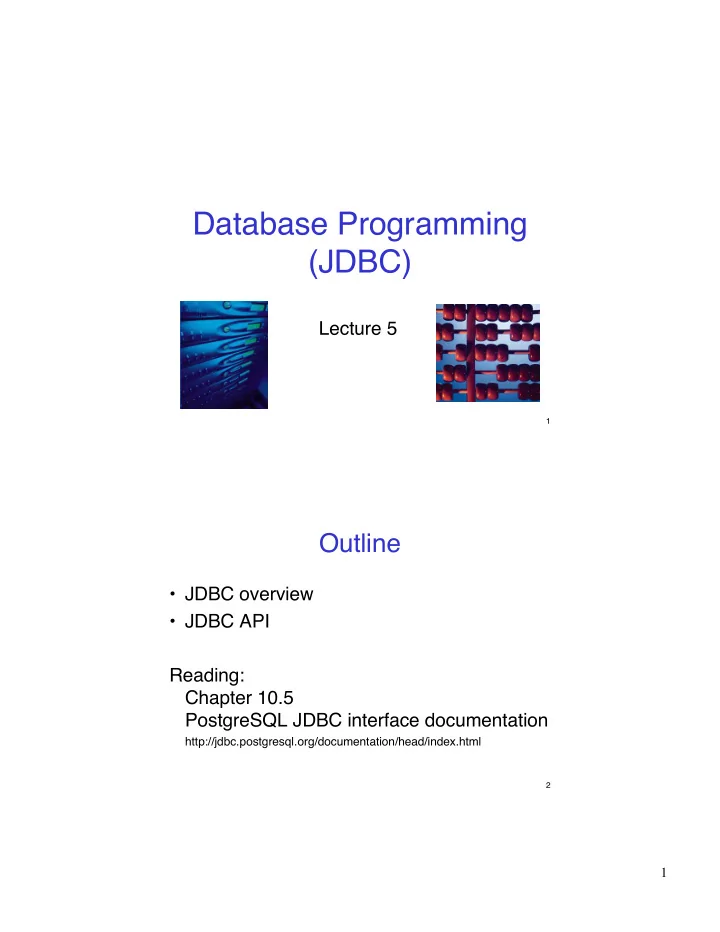

Database Programming (JDBC) Lecture 5 1 Outline • JDBC overview • JDBC API Reading: Chapter 10.5 PostgreSQL JDBC interface documentation http://jdbc.postgresql.org/documentation/head/index.html 2 1
Embedded SQL • Direct SQL (= ad-hoc SQL) is rarely used • In practice: SQL is embedded in some application code – user interaction, devices, programming logic • SQL code is embedded using special syntax into a host language 3 JDBC (Java DB Connectivity) Java application { ... "SELECT ... FROM ... WHERE" ... } DBMS 4 2
JDBC Drivers Java application JDBC-API JDBC- Driver manager Native JDBC- JDBC-ODBC Native Protocol driver Net-driver bridge API-driver DB- ODBC Client library Middleware Client library 5 Running a JDBC Application Phase Task Relevant java.sql classes Load driver DriverManager Initialisation Create connection Connection Statement Generate SQL statements Processing ResultSet etc. Process result data Terminate connection Connection Termination Release data structures Statement etc. 6 3
A Simple JDBC Application import java.sql.*; public class jdbctest { loadDriver public static void main(String args[]){ try{ getConnection Class.forName("org.postgresql.Driver"); Connection con = DriverManager.getConnection createStatement ("jdbc:postgresql://lsir-cis-pc8:5401/pcmdb", "user", "passwd"); execute(SQL) Statement stmt = con.createStatement(); ResultSet rs = stmt.executeQuery Result handling ("select name, number from pcmtable where number < 2"); while(rs.next()) yes System.out.println(rs.getString(1) + " (" + rs.getInt(2) + ")"); More stmt.close() results ? con.close(); no } catch(Exception e){ closeStatment System.err.println(e); }}} closeConnection 7 Loading of Driver • Creates an instance of the driver • Registers driver in the driver manager • Explicit loading String l_driver = "org.postgresql.Driver"; Class.forName(l_driver); • Several drivers can be loaded and registered 8 4
Implicit Driver Loading • Setting system property: jdbc.drivers – A colon-separated list of driver classnames. • Can be set when starting the application java -Djdbc.drivers=org.postgresql.Driver application • Can also be set from within the Java application Properties prp = System.getProperties(); prp.put("jdbc.drivers" "com.mimer.jdbc.Driver:org.postgresql.Driver"); System.setProperties(prp); • The DriverManager class attempts to load all the classes specified in jdbc.drivers when the DriverManager class is initialized. 9 Addressing Database • A connection is a session with one database • Databases are addressed using a URL of the form "jdbc:<subprotocol>:<subname>" • Examples jdbc:postgresql:database jdbc:postgresql://host/database jdbc:postgresql://host:port/database • Defaults: host=localhost, port=5432 10 5
Connecting to Database • Connection is established Connection con = DriverManager.getConnection(URL,USERID,PWD); • Connection properties (class Properties) • Close the connection con.close(); 11 Simple SQL Statements • Statement object for invocation stmt = conn.createStatement(); ResultSet rset= stmt.executeQuery( "SELECT address,script,type FROM worklist"); • ResultSet object for result processing 12 6
Impedance Mismatch • Example: SQL in Java: – Java uses int, char[..], objects, etc – SQL uses tables • Impedance mismatch = incompatible types • Why not use only one language? – SQL cannot do everything that the host language can do • Solution: use cursors 13 Using Cursors • Access to tuples – ResultSet object manages a cursor for tuple access – Example c1 c2 c3 c4 Statement stmt=con.createStatement(); ResultSet rset=stmt.executeQuery (“SELECT …”); while (rset.next()) { … } rset.close(); 14 7
Accessing Attributes (Columns) • Access to columns of a tuple – Using column index or column name Example c1 c2 c3 c4 while (rset.next()) { //return the value of the first column as a String String address = rset.getString(1); //return the value of the column “type” as a String String type = rset.getString(“type”) ... } 15 More on Cursors • Cursors can also modify a relation rset.updateString("script", "ebay"); rset.updateRow(); // updates the row in the data source • The cursor can be a scrolling one: can go forward, backward first(), last(), next(), previous(), absolute(5) • We can determine the order in which the cursor will get tuples by the ORDER BY clause in the SQL query 16 8
Inserting a row with Cursors rs.moveToInsertRow(); // moves cursor to the insert row rs.updateString(1, "AINSWORTH"); // updates the // first column of the insert row to be AINSWORTH rs.updateInt(2,35); // updates the second column to be 35 rs.updateBoolean(3, true); // updates the third column to true rs.insertRow(); rs.moveToCurrentRow(); 17 Dynamic JDBC Statements • Variables within SQL statement • Precompiled once, multiple executions • PreparedStatement for invocation PreparedStatement stmt = con.prepareStatement ( "SELECT * FROM data WHERE date = ?"); stmt.setDate (1, j_date); ResultSet rset = stmt.executeQuery(); 18 9
SQL Data Types • For passing parameters to prepared statements specific SQL data types are needed • Example java.util.Date jd = new java.util.Date(); java.sql.Date j_date = new java.sql.Date(jd.getTime()); 19 Update Statements • Updates have no result set int result = stmt.executeUpdate("delete from worklist"); • Return value of executeUpdate – DDL-statement: always 0 – DML-statement: number of tuples 20 10
Error Handling • Each SQL statement can generate errors – Thus each SQL method should be put into a try-block • Exceptions are reported through exceptions of class SQLException 21 Import java.sql.*; public class JdbcDemo { public static void main(String[] args) { try { Class.forName(com.pointbase.jdbc.jdbcUniversalDriver); } catch (ClassNotFoundException exc){ System.out.println(exc.getMessage()); } try { Connection con = DriverManager.getConnection(“jdbc:jdbc:demo", ”tux”,”penguin”); Statement stmt = con.createStatement(); ResultSet rs = stmt.executeQuery(“SELECT * FROM data”); while (rs.next()) {… process result tuples …} } catch (SQLException exc) { System.out.println(“SQLException: “ + exc.getMessage()); } } } 22 11
Metadata • Metadata allows to develop schema independent applications for databases – Generic output methods – Type dependent applications • Two types of metadata are accessible – on result sets – on the database 23 ResultSet Metadata • java.sql.ResultSetMetaData describes the structure of a result set object • Information about a ResultSet object – Names, types and access properties of columns 24 12
Database Metadata • java.sql.DatabaseMetaData provides information about the database (schema etc.) • Information about the database – Name of database – Version of database – List of all tables – List of supported SQL types – Support of transactions 25 Example ResultSet rset = stmt.executeQuery(“SELECT * FROM data”); ResultSetMetaData rsmeta = rset.getMetaData(); int numCols = rsmeta.getColumnCount(); for (int i=1; i<=numCols; i++) { int ct = rsmeta.getColumnType(i); String cn = rsmeta.getColumnName(i); String ctn = rsmeta.getColumnTypeName(i); System.out.println(“Column #” + i + “: “ + cn + “ of type “ + ctn + “ (JDBC type: “ + ct + “)”); } 26 13
Recommend
More recommend